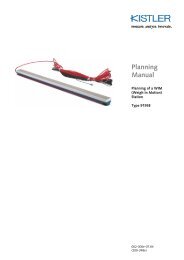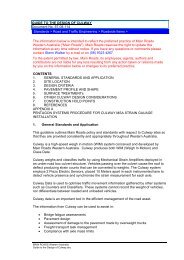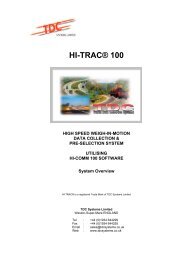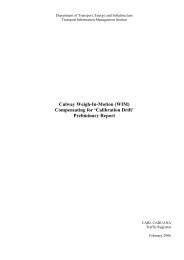AP-G84/04 Best practice in road use data collection, analysis ... - WIM
AP-G84/04 Best practice in road use data collection, analysis ... - WIM
AP-G84/04 Best practice in road use data collection, analysis ... - WIM
Create successful ePaper yourself
Turn your PDF publications into a flip-book with our unique Google optimized e-Paper software.
Accessed by AR - ARRB TRANSPORT RESEARCH on <strong>04</strong> Feb 2005<br />
<strong>AP</strong>PENDIX A – NATIONAL GLOSSARY OF TERMS<br />
Aust<strong>road</strong>s 20<strong>04</strong><br />
— 58 —<br />
<strong>Best</strong> Practices <strong>in</strong> Road Use Data Collection, Analysis and Report<strong>in</strong>g<br />
Annual Average Daily Traffic AADT is a measure of the average daily traffic pass<strong>in</strong>g a<br />
<strong>road</strong>side observation po<strong>in</strong>t over the period of a calendar<br />
year. One method of calculat<strong>in</strong>g AADT is by count<strong>in</strong>g the<br />
total volume of traffic pass<strong>in</strong>g an observation po<strong>in</strong>t and<br />
divided by the number of days <strong>in</strong> that year (365 or 366 days).<br />
Annual Average Weekday Traffic AAWT is the average 24 hour traffic volume on weekdays<br />
(Mondays to Fridays exclud<strong>in</strong>g public holidays) throughout a<br />
12 month period, at a specific observation po<strong>in</strong>t.<br />
Average Daily Traffic ADT is a sample of the AADT and is the traffic count<br />
averaged over a particular month, a week or a few days.<br />
Average Weekday Daily Traffic AWDT is taken as the average 24-hour count over a<br />
consecutive seven-day period from Monday to Sunday. It is<br />
often considered beca<strong>use</strong> of the empirical observation that<br />
the longer the count<strong>in</strong>g period <strong>use</strong>d to observe a traffic<br />
stream, the better the result<strong>in</strong>g estimates of the design<br />
parameters AADT or HHV.<br />
Average Weekday Traffic AWT is taken as the average 24-hour count over the period<br />
Monday to Friday. In some situations the average seven-day<br />
weekly traffic may be required and referred to as Average<br />
Weekday Daily Traffic (AWDT).<br />
Axle counts This is the number of actuations on an axle sensor such as a<br />
pneumatic tube as the wheels of vehicles cross over the<br />
sensor.<br />
Axle pair counts This is one half of the number of axle counts and is <strong>use</strong>d as<br />
an <strong>in</strong>dication of the number of vehicle counts. Axle pair<br />
counts are always less than the number of vehicles and can<br />
only be an approximation beca<strong>use</strong> a traffic stream will have<br />
vehicles with more than two axles. A correction factor is<br />
usually applied after calibration.<br />
Design Hour Volume DHV is the traffic flow rate chosen as the design traffic load<br />
for a facility over its design life. Common <strong>practice</strong> is to<br />
choose an ‘nth’ HHV as the design volume, with the 30 th<br />
highest hourly volume often <strong>use</strong>d <strong>in</strong> a rural environment and<br />
the 80 th HHV <strong>in</strong> an urban area. The 100 th HV (or 100 HV) is<br />
<strong>use</strong>d on National Highways. This probabilistic concept is<br />
chosen beca<strong>use</strong> it is uneconomic, if not impossible, to<br />
design a facility realistically to meet the highest traffic flow<br />
rate.

















